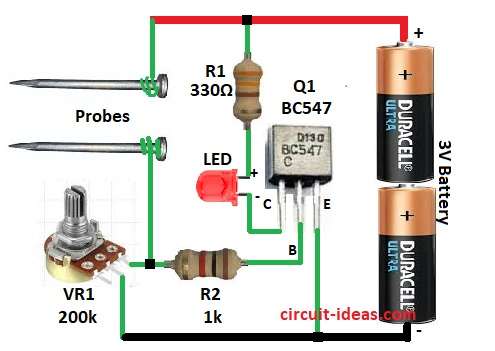Humidity is presence of water vapor in air or soil.
Too much or too less humidity is harmful for plants and for storage.
So we need a Simple Humidity Level Detector Circuit.
This small circuit uses only few parts and gives LED indication when humidity crosses a level.
It can be used to test soil moisture also.
Circuit Working:

Parts List:
| Component | Description |
|---|---|
| Resistors | 330 ohms 1/4 watt |
| 1k ohms 1/4 watt | |
| Potentiometer 200k | |
| Semiconductors | Transistor BC547 |
| Battery 3V | |
| LED any color | |
| Any iron nail, pin clip or metal wires as probes |
Many humidity tester circuits are there, but this one is very simple and its working is easy to understand.
Only one transistor, one LED and few resistors are used.
It can test humidity in soil, paper and other material.
When humidity increases the material conducts more current.
This current goes through VR1 and if voltage across VR1 becomes 0.7V then transistor turns ON and LED glows.
Potentiometer VR1 is used to adjust sensitivity and by turning knob changes resistance and changes how much humidity level is needed to switch a transistor.
R1 is used to limit current of LED and also protect transistor when probes are short.
To set circuit put probes in sample and adjust VR1 until LED just glows.
After that whenever humidity of sample reaches that level then LED will glow.
Probes are two metallic wires inserted in soil.
Distance between probes affects the sensitivity.
This circuit runs on 3V battery.
Formulas and Calculations:
Following are the simple formulas for Humidity Level Detector Circuit.
Transistor BC547 needs base current (Ib) to turn ON.
Ib = Ic / hFE
where,
- Ic is collector current
- hFE is current gain which is normally 100 to 200 for BC547.
LED current needed around 5mA to 10mA.
So if Ic = 10mA and hFE = 100
Ib = Ic / hFE = 10mA / 100 = 0.1mA
So probes and resistor R2 and VR1 must allow at least 0.1mA current at humidity condition.
With 3V supply and R2 is 1k then maximum base current possible is around 3mA which is enough to drive a LED.
How to Build:
To build a Simple Humidity Level Detector Circuit follow the below steps for connections and assembling:
- Take all the parts as shown in circuit diagram
- Connect transistor Q1 collector pin to LED and R1 resistor
- Connect transistor Q1 base pin to probe via R2 resistor and potentiometer VR1
- Connect transistor Q1 emitter pin to battery negative
- Probes one end is connected to positive supply of 3V battery and other end is connected to resistor R2 and VR1 pot.
Leave a Reply